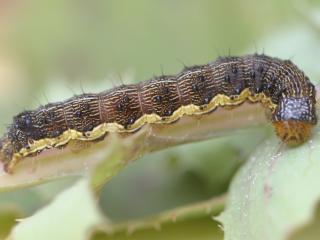Native budworm
Caterpillar activity
- Yuna
- Eurardy
- Yandanooka
- Wittenoom Hills
Technical officer Dave Nicholson (DPIRD) reports finding 26 native budworm caterpillars (19-38mm in length) per 10 sweeps in a podding lupin crop near Yuna. Some of the caterpillars were beginning to enter the lupin pods and chew on the developing seed.
Native budworm caterpillars (one per 10 sweeps) have also been reported in a lupin crop at Eurardy.
Native budworm caterpillars (two per 10 sweeps) were found in canola crops at Yandanooka and Wittenoom Hills.
The feeding behaviour of native budworm caterpillars changes according to the type of crop the caterpillars are feeding upon. Field pea, chickpea, lentil and faba bean crops are very susceptible to all sizes of caterpillars during the formation and development of pods. Tiny caterpillars can enter developing pods and damage seed or devour the entire contents of the pod.
Narrow-leafed lupin pods and seeds will not be damaged by native budworm until they are close to maturity and the pods are losing their green colouration. Pod walls are not penetrated until the caterpillars are over 15mm in length. The decision to spray a lupin crop should not be made until caterpillars are greater than 15mm in length and the pods are losing their green colour. At this stage it is difficult to use a sweep net as the lupin plants are stiff and the pods are spiky. An alternative to sweeping is to cut plants from several places in the crop and shake them into a bin to count caterpillar numbers. Taking small areas from the crop, say a quarter or a tenth of a square metre, or a number of plants equal to that found in a square metre, is the easiest method for assessing damage levels for the entire crop.
Canola is similar to narrow-leafed lupin in that canola pods only become attractive to caterpillars as the crop nears maturity and begins to hay-off. Caterpillars of all sizes will enter pods at this stage, with larger caterpillars doing the most damage. Native budworm can also cause damage after a canola crop has been swathed. This will occur if the crop is swathed when many pods are still green with soft seed. Seed damage from native budworm increases in swathed crops if drying is prolonged due to cool damp conditions.
Native budworm moth trapping surveillance
- Usual automated and manual trapping locations
The larger native budworm flights recorded by budworm trappers this week include: Southern Cross (157 moths), Wyalkatchem (113), Dowerin (101), Grass Patch (97), Kellerberrin (92), Northampton (78), Dalwallinu (71), Cunderdin (19) and Badgingarra (16).
Results of this week's manual trappings are available at the department’s Native budworm moth numbers 2021.
A mapped view of the native budworm trap captures is available at Cesar Australia’s MothTrapVisWA page. Viewers need to select the desired trapping date range.
Pesticide options for the control of native budworm can be found in DPIRD’s 2021 winter spring insecticide guide.
Detailed information on this pest can be found at DPIRD’s Management and economic thresholds for native budworm page or listened to on the recently published Native budworm podcast.
For more information contact Technical Officer Alan Lord, South Perth +61 (0)8 9368 3758 or +61 (0)409 689 468.
Article author: Alan Lord (DPIRD South Perth).

